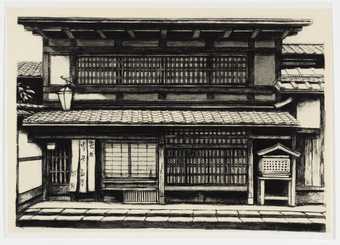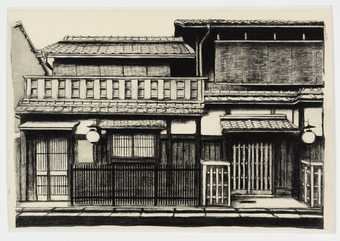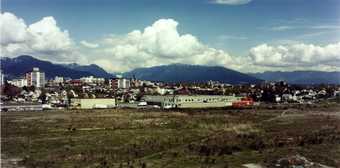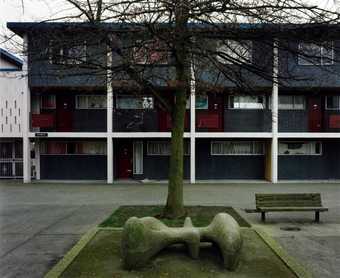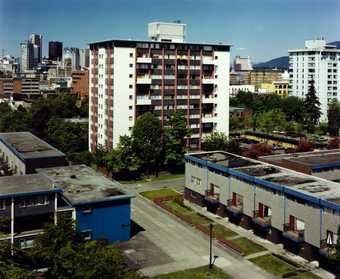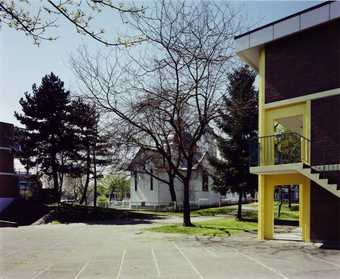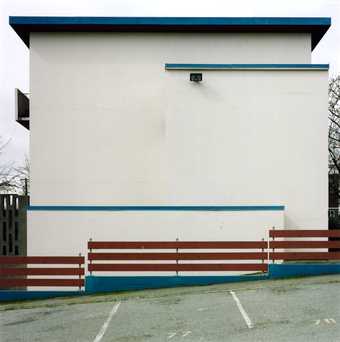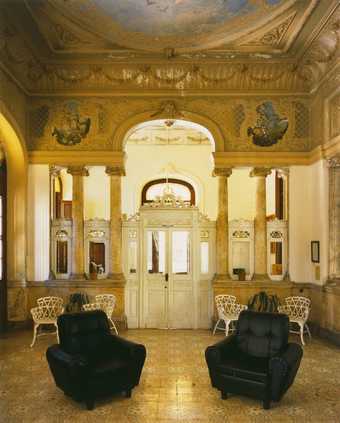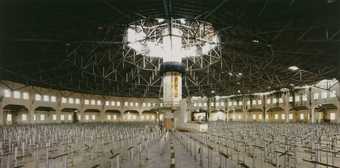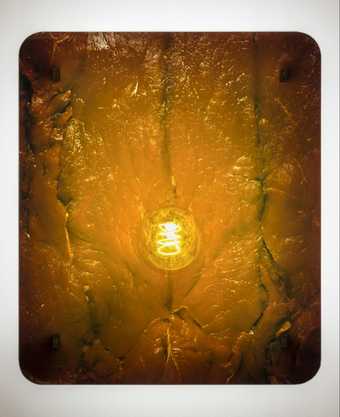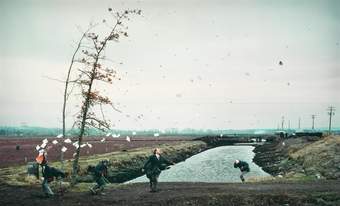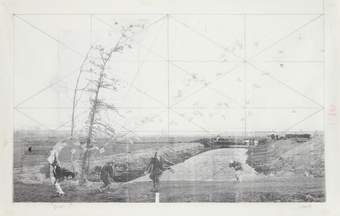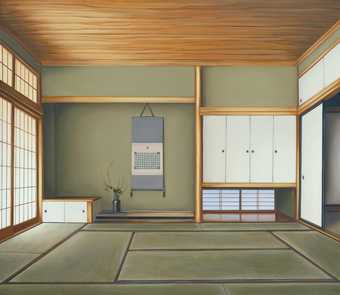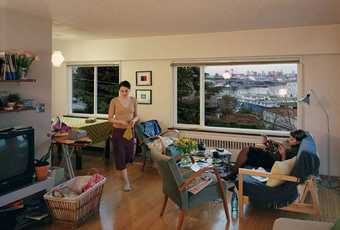
Not on display
- Artist
- Jeff Wall born 1946
- Medium
- Transparency on lightbox
- Dimensions
- Unconfirmed: 400 × 460 mm
- Collection
- Tate
- Acquisition
- Purchased 2003
- Reference
- T07961
Summary
Diagonal Composition is a colour photograph of the detail of an interior. Like the majority of Wall’s images, it is displayed in a light box. It represents a balanced composition of dynamically intersecting and crossing parallel and diagonal lines, the result of viewing and framing the subject from a particular angle. Part of an enamel sink in the foreground is surrounded by a yellow formica surface, the lines of which are sharply defined by metal edging running parallel to the sides of the sink. The intersection of the metal strips at the rear corner of the sink is slightly to the left of the centre of the photograph. They frame a bar of soap and lump of white detritus lying on the formica next to the sink. To the right, a small dark shelf extends into the upper right side of the image, its rounded corner echoing the rounded corner of the sink in the foreground directly below it. Behind the shelf, a strip of light blue formica is nailed to the white wooden planks on the wall. White concrete below the shelf is brightly lit, revealing the trace of a cobweb hanging from the shelf’s metal trim. A vertical shadow on the right side of the photograph echoes the shadow inside the sink. Above the brown formica panel behind the sink is a plank of wood, its grain running at right angles to the printed grain of the formica. It is parallel to the metal strip at the back of the sink, the blue formica at the back of the shelf and the narrow dark margin at the upper edge of the white concrete. A piece of coarsely woven fabric draped over the wood disappears out of the picture frame and then reappears, hanging directly above the soap. The surfaces between the diagonal lines of the composition are discoloured with age and use. Splashes and smears of white, rust stains and two circular imprints left by objects standing on the shelf for a long time have a painterly quality. The photograph was taken in Wall’s basement studio. It is life sized.
Diagonal Composition is one of a small number of works Wall has produced which focus on empty interiors with still-life resonances. Wall was born and raised in Vancouver, Canada and trained initially as a painter at the University of British Colombia. After completing an MA in 1970, he moved to London to undertake doctoral research in art history at the Courtauld Institute (completed 1973). Dissatisfied with established artistic forms, he was searching for his own medium. He explained:
What interested me ... was to make pictures that had specific relationships with certain kinds of painting ... certain kinds of cinema ... and certain kinds of photography ... and to find a way of hybridising all that I admired about all those things ... I thought, for my purposes, that painting needed to be more psychologically intense, cinema needed to be ‘arrested’ (according to the concepts from Barthes and Benjamin), and photography needed to be made more viable at the scale of the human body, the scale of natural vision, a scale that painting had mastered.
(Quoted in Matthew Barney, Tony Oursler, Jeff Wall, exhibition catalogue, Sammlung Goetz, Munich 1996, p.89.)
In 1977, on a coach journey from Barcelona to London, Wall was struck by something he had seen many times before without remarking. A back-lit bus stop advertisement triggered the solution for combining the elements described above. The large-scale back-lit photographic transparency became Wall’s signature medium. Unlike a painting which reflects light, the light box emanates light, filtering it through the photographic image. In common with film, the image relies on a space which is hidden. For Wall, this inaccessible space is a source of disassociation, alienation and power (Barents, p.99). Referring to his images as ‘pictorial typologies’, he has commented that his aim is ‘to represent both the surface of damaged life, and its opposite, the possibility of another life, one which will come out of this one as its negation’ (quoted in Barents, p.102). Staged in the manner of classical paintings, Wall’s photographs subvert the celebratory and idealising politics traditional to that genre. Characters in his works of the 1980s represent, and subtly comment on the plight of, ethnic minorities, the working class poor and other traditionally abject aspects of society. Where he represents landscapes, Wall selects locations in which nature is impinged upon by suburbia or industrialisation. In Diagonal Composition, such details as the cracked and dirty bar of soap and the lump of unidentifiable crumpled white detritus recall the page of Involuntary Sculptures – close-up photographs of small fragments of everyday life - by Gyula Brassaï (1899-1984) and Salvador Dali (1904-89) which were published in the Surrealist magazine Minotaure in 1933. With its worn and soiled surfaces, Diagonal Composition presents an ordinary, although usually disregarded, corner of life as a harmonious and beautiful whole.
Diagonal Composition was produced in an edition of ten, of which this is the seventh.
Further reading:
Else Barents, Jeff Wall: Transparencies, Munich 1986
Jeff Wall, exhibition catalogue, Chicago Museum of Contemporary Art, Galerie Nationale du Jeu de Paume, Paris, Whitechapel Art Gallery, London 1995, pp.23-6, reproduced p.67 in colour
Brony Fer, ‘The Space of Anxiety: Sculpture and Photography in the Work of Jeff Wall’, Sculpture and Photography: Envisioning the Third Dimension, ed. Geraldine A. Johnson, Cambridge 1998, pp.234-45, reproduced p.235
Elizabeth Manchester
July 2003
Does this text contain inaccurate information or language that you feel we should improve or change? We would like to hear from you.
Explore
- emotions, concepts and ideas(16,416)
-
- formal qualities(12,454)
-
- photographic(4,673)
- domestic(1,795)
- sink(19)
You might like
-
Lisa Milroy Kyoto House
1996 -
Lisa Milroy Kyoto House
1996 -
Stan Douglas Strathcona and False Creek Flats
1998 -
Stan Douglas Biomorphic Sculpture at McLean Park
1998 -
Stan Douglas The West Tower of McLean Park
1998 -
Stan Douglas Russian Orthodox Church at Stamps Place
1998 -
Stan Douglas Abstract Composition
1998 -
Stan Douglas Quinta Rosario / “Fructuoso Rodríguez” Secondary School, Vedado
2004 -
Stan Douglas Mess Hall, Isla de Pinos / Isla de la Juventud
2005 -
Helen Chadwick Enfleshings I
1989 -
Helen Chadwick Enfleshings II
1989 -
Jeff Wall A Sudden Gust of Wind (after Hokusai)
1993 -
Jeff Wall Study for ‘A Sudden Gust of Wind (After Hokusai)’
1993 -
Lisa Milroy Room
1997 -
Jeff Wall A View from an Apartment
2004–5

